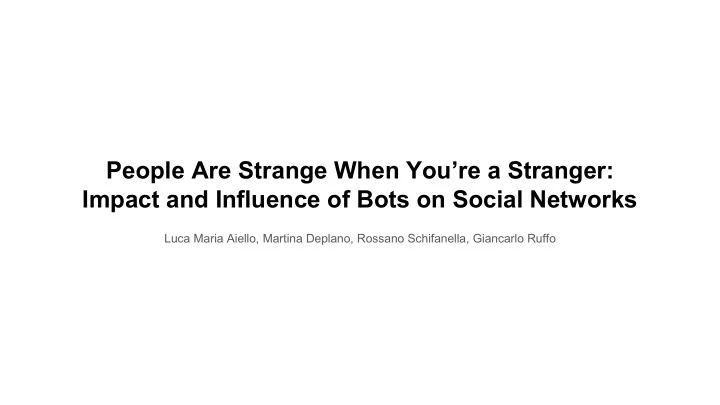

People Are Strange When You’re a Stranger: Impact and Influence of Bots on Social Networks Luca Maria Aiello, Martina Deplano, Rossano Schifanella, Giancarlo Ruffo
Objective ● To what extend a bot with no trust, no profile, and no aims to reproduce human behavior, can become popular and influential in a social media.
Contribution 1. Provide explanations on the roots of popularity and influence in a social media context 2. Give useful insights about how a social recommender (or spammer) can be extremely effective 3. Provide a direct test of accuracy of modern recommendation techniques on a real user base 4. Show how the intervention of an external, anomalous entity in a social network can alter its dynamics and unveil social polarization phenomena
Methodology ● Set up experiment on aNobii.com, a social network for book lovers ○ Users socialize by means of thematic groups and by establishing pairwise social connections. ○ Social ties are directed and can be created without any consent of the linked user. ○ Every profile page contains a public shoutbox, where any user can write messages. ● Started collecting data in September 2009 through a periodic activity of Web crawling ● In July 2010 the default user settings of the website silently changed so that every visit of a logged user automatically started leaving a trace in a private guestbook of the visited profile. ● Motivation : Set up a social experiments in two parts to answer the question “can an individual with no trust gain popularity and influence?”. ○ kept running the periodic crawling to check the variation over time of the user response to the bot visits. ○ ran a modified version of our bot that was able to communicate with other users, asking them to take some action.
Analysis- Gain of popularity ● A clear positive correlation between the number of incoming messages with the amount of books publicly shown in the library and with the amount of sent messages ● As soon as the new aNobii settings on visits took place in July 2010, our bot started collecting a massive response from visited users, and every round of visits triggered a burst of comments on the bot’s public wall. ● Figure 3 shows the histogram of the number of visits in time. ● The rapid bursts of messages happening after the visits do not trigger any self-feeding effect in the incoming communication stream. ● At the end of its activity, lajello’s profile has become one of the most popular in the website, boasting 2,435 public messages from 1,263 different users, more than 200 private messages, more than 66,000 visits to its profile, and 211 incoming social connections (partitioned in 125 neighbors and 86 friends).
Analysis- Influence ● Second Phase- the bot tries to convince users to perform an action ○ Persuading users to add a new neighbor in their contact list ● Among the 361 users who created at least one social connection in the 36 hours after the recommendation, the 52% followed the suggestion given by the bot. ● lajello has a greater persuasive power over those who are more aware of its presence and activity.
Analysis- Influence ● From a social network analysis perspective, we observe that untrustworthy individuals in social media can become influent if they have enough popularity, which can be gained with automated activity. ● From the service provider angle instead, we learn that a social recommender can be very effective (52% of success ratio in our case). This suggests that many recommendations that are labeled as false positives in data driven studies may result to be successful when they are actually proposed to the end user.
Analysis- Emotional reactions and social polarization 1. Sentiment analysis on the messages a. Several users openly expressed in their messages the fear of control or the perception of a strong privacy violation. b. On average, we found that 59% of messages have a positive connotation and 16% are negative instead. 2. Evidence of user polarization into two opinion clusters was given by applying OSLOM community detection algorithms to the networks and checking whether the detected clusters match the group membership of nodes
Conclusion ● Popularity in social networks does not require peculiar user features or actions, since an automated agent can acquire a surprisingly high popularity just by reiterating a simple activity of “social probing”. ● As evidence that an untrustworthy user can be very influential if popular enough, results show that people more aware of the presence of the bot have been more inclined to follow its suggestions. ● They registered profound social dynamics alterations.
Recommend
More recommend